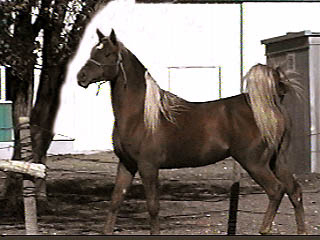
to FARAFRA ARABIANS
IBN IBN RG AL MONE - Straight Egyptian, Al Khamsa
 INTERESTING FACTS:
INTERESTING FACTS:
The
unique outline of the Arabian horse is determined by the formation of its
skeleton, which differs from other equine breeds in several respects,
The Arabian horse
has:
(1) 17 ribs (other horses
have 18)
(2) five lumbar
vertebrae(other horses have 6)
(3) 16 tail vertebrae (other
horses have 18)
The oldest and purest
of all horse breeds, the Arabian horse is considered by many people to be
the most beautiful equine animal in the world. With it's refined head and
dished profile, expressive eyes, high spirits and unique floating action,
it is certainly one of the most exquisite of creatures. More than any
other horse, it is the Arabian which has influenced the development of
equine breeds throughout the world.
This Arabian influence was initiated in the seventeenth and early
eighteenth centuries AD when the followers of Islam spread across North
Africa and to Spain. The Arabians they took with them were greatly
superior to the native stock of other lands and so began a process of
upgrading through the introduction of Arabian blood,Wednesday October 23, 2002
that was to go on for many centuries and still goes on today. Pure-bred
Arabians are now bred throughout the world. As well as appearing in the
show ring, they are particularly suited to the sport of endurance riding.
In recent times, there has been a resurgence of interest in Arabian
racing.
